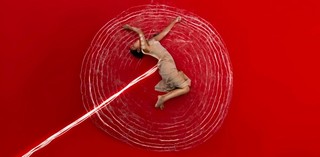The 11th Asia Pacific Triennial of Contemporary Art

Kawita Vatanyankur, Thailand b.1987 / Pat Pataranutaporn, United States b.1995 / The Machine Ghost in the Human Shell (from the ‘Cyber Labour’ series) 2024 / Performative hologram projections with AI / Commissioned for ‘The 11th Asia Pacific Triennial of Contemporary Art’ / © Kawita Vatanyankur / Courtesy: The artist and Nova Contemporary / View full image
When
30 Nov 2024 – 27 Apr 2025
Where
Queensland Art Gallery & Gallery of Modern Art
About
Seventy artists, collectives and projects from more than 30 countries feature in the eleventh chapter of the flagship Queensland Art Gallery | Gallery of Modern Art (QAGOMA) exhibition series, the Asia Pacific Triennial of Contemporary Art.
Bringing compelling new art to Brisbane, the Triennial is a gateway to the rapidly evolving artistic expression of Australia, Asia and the Pacific. Alongside artists and makers whose work has not been previously seen in Australia are a raft of new co-curated projects investigating artforms and cultural contexts rarely encountered outside their home localities.
For the first time this Triennial includes creators from Saudi Arabia, Timor-Leste and Uzbekistan, while First Nations, minority and diaspora cultures hold a central place, as do the collective, performative and community-driven modes of artmaking that thrive in the region. Through nuanced approaches to storytelling, materials and technique the exhibition explores themes that resonate across these cultural landscapes, such as how we care for the natural and urban environments, protect and revive cultural heritage, and how histories of migration and labour shape experience today.
As always, the Triennial is conceived and shaped from the ground up by expert hands. Artists, curators, interlocutors, cultural allies and partners have meaningfully woven the region’s creative stories into an exhibition that will inspire, uplift and move you.
Works in this exhibition are protected under the Australian Government’s Protection of Cultural Objects on Loan Act 2013. Find out more.
List of Artists
- 'Aunofo Havea Funaki and the Lepamahanga Women’s Group
- Kim Ah Sam
- Bernice Akamine
- Ana Estrada, Nasrikah, Okui Lala
- Tully Arnot
- Ataúro sculptors
- AWA (Artists for Waiapu Action)
- Dana Awartani
- Dulguun Baatarsukh
- William Bakalevu
- Nadiah Bamadhaj
- BOLOHO
- Etson Caminha
- CAMP
- Szelit Cheung
- Masaya Chiba
- Community Partners Program
- Trương Công Tùng
- Karla Dickens
- Harold ‘Egn’ Eswar
- Lê Giang
- Angela Goh
- Brett Graham
- Abdul Halik Azeez
- Ishu Han
- D Harding
- Abolfazl Harouni
- Haus Yuriyal
- Shahla Hosseini
- Katsuko Ishigaki
- Saodat Ismailova
- Mit Jai Inn
- Mele Kahalepuna Chun
- Madina Kasimbaeva
- KAWAKI and Dreamcast Theatre
- Kawita Vatanajyankur and Pat Pataranutaporn
- Bùi Công Khánh
- Kikik Kollektive
- Laresa Kosloff
- Mariano Lafu
- Zac Langdon-Pole
- Jeremy Leatinu‘u
- Muhlis Lugis
- Eleng Luluan
- Yim Maline
- Rithika Merchant
- Mindanao and the Sulu Archipelago: Roots and Currents
- Sancintya Mohini Simpson
- Filwa Nazer
- Dawn Ng
- Mai Nguyễn-Long
- Nomin Bold and Ochirbold Ayurzana
- Haji Oh
- Paemanu Ngāi Tahu Contemporary Visual Arts
- Sarker Protick
- Joydeb Roaja
- Varunika Saraf
- Chung Seoyoung
- Wardha Shabbir
- Hema Shironi
- Darrell Sibosado
- TAMBA
- Lê Thuý
- Jasmine Togo-Brisby
- Yeung Tong Lung
- Torba Weavers
- Wang Tuo
- Alexander Ugay
- Charles Lim Yi Yong
- Albert Yonathan Setyawan
- Zhang Xu Zhan

